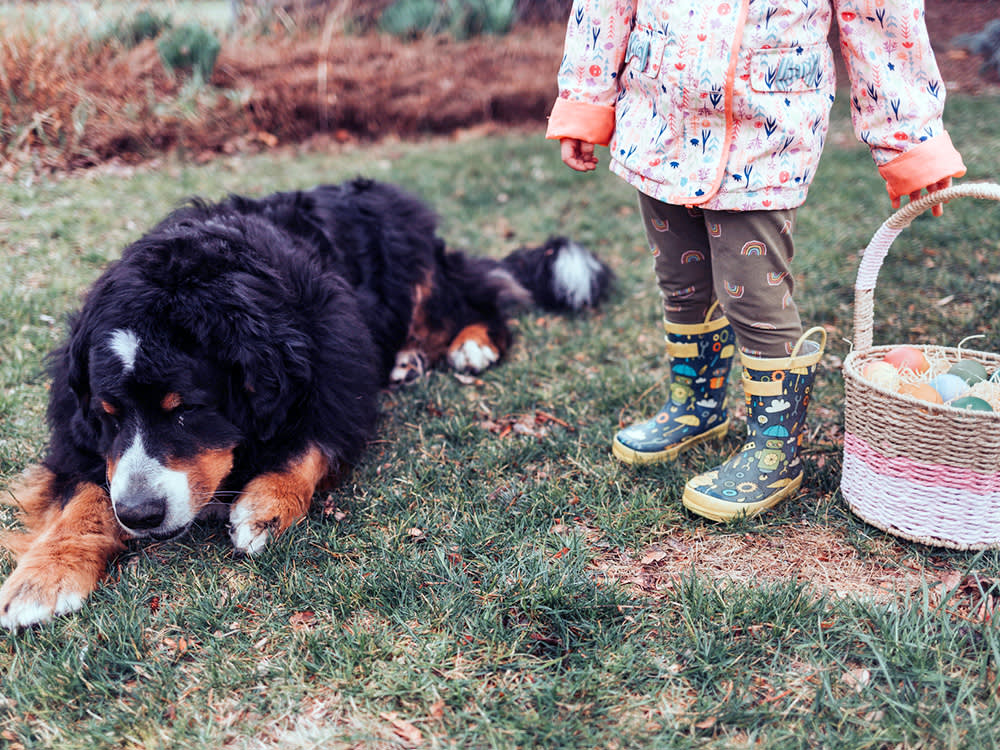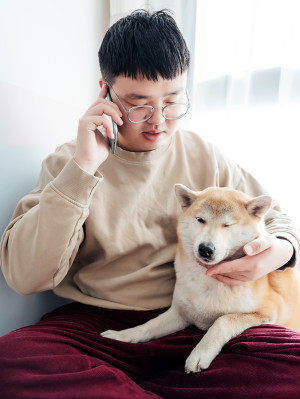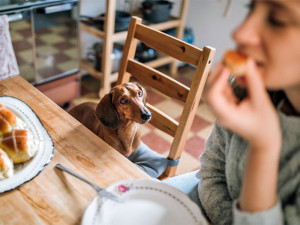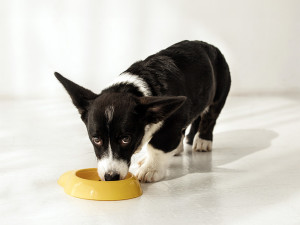How to Organise an Easter Egg Hunt For Your Pup
Want to include your four-legged family member in the seasonal fun? Of course you do

share article
As the Easter season rolls around, it’s not just humans who want to get involved in the festivities; our furry companions deserve a slice of joy, too. From dog-friendly Easter egg hunts to seasonal treats, there’s a plethora of ways to make this holiday special for your canine companion. However, it’s crucial to navigate Easter delicacies carefully, keeping in mind what dogs can and cannot eatopens in a new tab. Dive into the world of Easter egg hunts for dogs, whilst ensuring their safety and enjoyment throughout the festivities.
Easter activities for dogs: what treats to use
Before we dive into the Easter fun, it’s essential to understand what treats are safe for our dogs. Whilst we’re lucky enough to indulge in chocolate and other tasty treats, it’s essential to remember that many human foods can be harmful to dogs.
What dogs can eat at Easter
Dog-friendly Easter treatsopens in a new tab: opt for specially formulated dog treats that are Easter-themed. These treats are designed with canine health in mind, ensuring they’re both delicious and safe. Look for reputable brands that use high-quality ingredients suitable for dogs.
Fresh fruits and vegetables: treat your pup to their five-a-day as a healthy Easter snack. Applesopens in a new tab, blueberries and celeryopens in a new tab are excellent options that most dogs adore to crunch on. Just be sure to remove any seeds or pits that could potentially be a choking hazard.
Plain cooked meat: if you’re planning a special Easter meal for your pup, plain cooked meat such as chicken or turkey can make for a tasty and protein-rich treat. Lamb is a seasonal treat that is filled with amino acids and protein for pups, just make sure they aren’t given any cooked bones and avoid seasoning or sauces, as these can upset your dog’s stomach.
What dogs cannot eat at Easter
Chocolate: one of the most well-known hazards for dogs during Easter is chocolate. The compound theobromine found in chocolate can be toxic to dogsopens in a new tab and may lead to symptoms ranging from vomiting and diarrhoea to heart palpitations and seizures, and, in extreme cases, even death. It’s essential to keep all chocolate products, including Easter eggs, out of reach of your furry friends.
Xylitol: this sweetener is a sugar substitute that is often found in sugar-free treats, but can also be a hidden ingredient in everyday items such as peanut butter. Keeping an eye on food labels is essential, as even small amounts of xylitol can cause a dangerous drop in blood sugar levels and liver failure in dogs.
Grapes and raisins: a staple in many Easter treats, grapes and raisins are extremely toxic to dogs, potentially causing kidney failure. Keep hot cross bunsopens in a new tab and fruitcakes containing these ingredients well away from your pup.
How to organise a dog-friendly Easter egg hunt
Now that we’ve covered the dos and don’ts of safe Easter treats for dogsopens in a new tab, let’s dive into the highlight of Easter for dogs: Easter egg hunts. Just like children, dogs love the thrill of the hunt, and organising an Easter egg hunt for your pup can provide hours of entertainment and mental stimulation.
Encourage their natural instinct to sniff and search with a few simple steps.
Choose a safe location: opt for a secure and spacious outdoor area if you can such as your garden or a local park where your dog can roam freely without the risk of getting lost or injured. If you only have indoor space, don’t worry – you can still host a mini hunt inside, just make sure to move any hazards out of the way beforehand.
Hide dog-friendly treats: instead of traditional chocolate eggs, hide dog-friendly Easter treatsopens in a new tab such as small pieces of cooked chicken, commercial dog treats or themed toys in various hiding spots around the area. You can also hide toys or puzzle feeders to add variety to the hunt.
Let the hunt begin: release your dog and watch as they eagerly sniff out the hidden treats. If your dog already has a cue such as ‘find it’, use it. Otherwise, you might have to guide your dog slightly to the first hiding spot.
Reward and encourage: when your pup finds a treat, verbally reward your dog with plenty of praise (and cuddles, if you insist) for their hard work and determination, so they know this is the behaviour you want, and they then go off and find the rest of the treats.
Supervise to stay safe: keep a close eye on your dog during the hunt to ensure they don’t eat anything that is toxic to dogs or overexert themselves. If your dog becomes overwhelmed or tired, take a break and offer plenty of water and rest.
Practising moderation
While Easter egg hunts can be an exciting adventure for dogs, it’s essential to supervise them closely and ensure that they don’t ingest any non-edible items or overindulge in treats. Keep a close eye on your furry friend throughout the hunt and intervene if necessary to prevent any accidents or mishaps.
As always, it’s crucial to practise moderation when it comes to treats, even those that are safe for dogs. Overindulgence can lead to digestive upset and weight gain, so be mindful of how many treats you’re offering your pup during the Easter festivities. As a rule of thumb, treats should only make up 10 percent of your dog’s daily caloric intake. If you’re pushing that 10 percent already, consider hiding some of their ‘normal’ food portions from the day – dry food can be a great option, especially if your pup is heavily food-driven, as the pieces of kibble are so small.

Orla Pentelow
Orla Pentelow is a freelance journalist and copywriter based in London. When not at her desk she’s out and about with her rescue dog, Luna, who works primarily as chief distractor.
Related articles
![Beagle puppy dog holding a peeled carrot in its front paws sitting in the grass]() opens in a new tab
opens in a new tabCan Dogs Eat Carrots?
Yes, this crunchy, sweet vegetable is a great addition to your dog’s diet
![German Shepherd with Bunny ears and Easter products around]() opens in a new tab
opens in a new tabThe Best Easter Treats and Toys For Dogs
How to include your pup in the Easter celebrations (no chocolate allowed)
- opens in a new tab
Can Dogs Eat Hot Cross Buns?
Sometimes ‘sharing is caring’ isn’t the best advice
![black and white Corgi puppy eating out of a yellow dog bowl]() opens in a new tab
opens in a new tabCould Your Dog’s Diet Be Changing Their Behaviour?
It turns out the saying ‘you are what you eat’ isn’t just for humans




